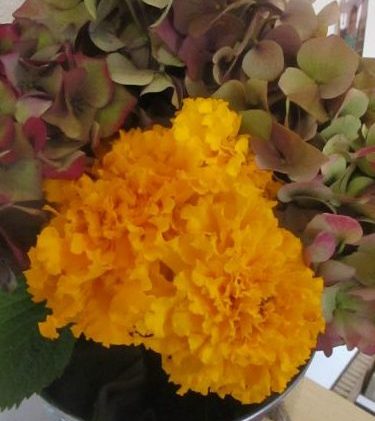Math and science are aspects of early childhood education that can be learned through plants. Columbine and spider wart are two plants that have unique petals and leaves; each plant allows for children to learn about how a plant grows and incorporates numbers and patterns.
There are a couple of ways I will mention that a provocation for math and science can be set up for children to question, explore and learn from. First I like to set up a potted plant or fresh cut flowers so that the children can admire the plant and incorporate both art and literacy by drawing a picture of each and writing a story about them based on any inspirational ideas that come forward by admiring the plant or flowers (I act as their scribe). Math comes in to play when the children can, in essence, dissect the plant visually and artistically; drawing the leaves, the vanes, and the petals. As their scribe, I can dialogue with the children and model how to write/draw numbers for each part of the plant they have illustrated. For science, we can explore the role and purpose of soil, the nutrients it contains, and the rain and sunshine’s impact on the plants. So as you can see we actually are encompassing not simply math and science, we are including art and literacy; four content areas are being explored and utilized in a natural and holistic way of teaching and learning. No worksheets or artificial methods are being used to teach something that is freely available in all of nature.
 California poppy is another commonly grown flower that can easily be used to teach math and science. I enjoy taking pictures, but I love planting with children and allowing them to be responsible for the care and maintenance of a plant or flower. As each child watches a seed transform we learn how the sun, rain, and soil cause a seed to grow. I introduce actual scientific terminology and age-appropriate reading with illustrations to support the children’s learning. Of course, if we are exploring plants and how they grow it is because the children have shown and communicated a strong interest. When children have internal interest their attention spans are quite long and a simple question turns into a month or more long project. 🙂 I do not introduce complicated vocabulary for the children to memorize or know off hand, rather I introduce the terms as a way of building a foundation for further information to be added as the child gains his/ her understanding of how plants grow and thrive.
California poppy is another commonly grown flower that can easily be used to teach math and science. I enjoy taking pictures, but I love planting with children and allowing them to be responsible for the care and maintenance of a plant or flower. As each child watches a seed transform we learn how the sun, rain, and soil cause a seed to grow. I introduce actual scientific terminology and age-appropriate reading with illustrations to support the children’s learning. Of course, if we are exploring plants and how they grow it is because the children have shown and communicated a strong interest. When children have internal interest their attention spans are quite long and a simple question turns into a month or more long project. 🙂 I do not introduce complicated vocabulary for the children to memorize or know off hand, rather I introduce the terms as a way of building a foundation for further information to be added as the child gains his/ her understanding of how plants grow and thrive.
There are many different provocations and projects that can be explored through the use of nature and I enjoy seeing each child come to his/ her own understanding through inquiry, exploration, manipulation, and implementation. Either individually or as a collaborative effort young minds construct knowledge, and as the Teacher, I am a facilitator and support to their ever constant and changing development of knowledge.
You as Parents or Grandparents are a constant source of knowledge and support for your young child and together we work as a team preparing young minds for their future educational careers. 🙂
Heidi, The Marigold School of Early Learning


Reblogged this on Violet's Veg*n e-Comics.
LikeLike
Reblogged this on aprilseverydayblog.
LikeLike
You are absolutely on the mark with this information. I taught fourth graders and used the method you described. Being a math/science specialist and an artist really helped me address all learning styles in a fun way without worksheets! It’s such a treat to hear from like minded bloggers 🙂
LikeLike
Great way to teach math and science.
LikeLike
Beautiful!
LikeLike
Reblogged this on Hush, Lola! and commented:
Here’s another way plants can be incorporated into STEM education!
LikeLike